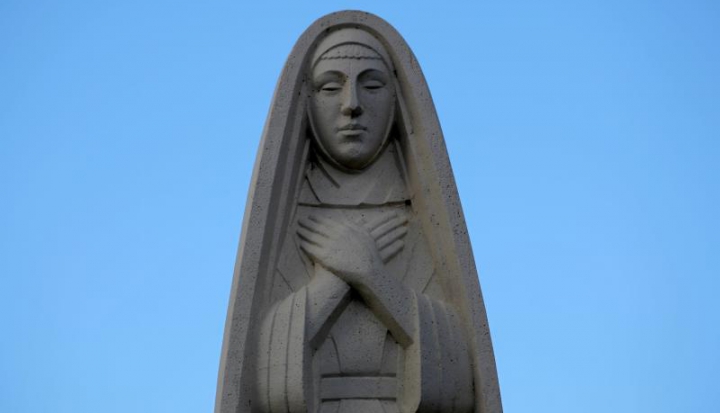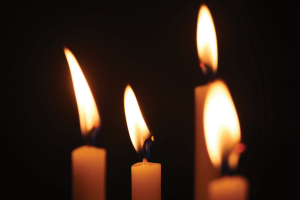It’s a new year, and time to get cracking on those resolutions. In addition to those vows to exercise regularly, eat better, save money, get organized, and call Mom more often, make room on your list for one more improvement: spiritual growth.
We know what you’re thinking: This year, you’ll start every day by attending Mass or saying the rosary, or participating in Morning Prayer. Or maybe you just want to get to Confession or adoration more often. Or you think you’re finally ready to take that eight-day retreat. Whoa—not so fast! Some of you (those who quit smoking cold turkey thanks to a previous New Year’s resolution) might manage to make good on those goals, but the rest of us would be wise to take some spiritual baby steps.
Instead of resolving to become a mystic by December only to abandon your promise before March, take a look at our spiritual fitness guide, a list of practices that will stretch your soul in less than 10 minutes a day. We promise that if you adopt any one of them, you’ll be in better spiritual shape at the end of this year than you were at the beginning.
BIG GOAL
Daily Mass
Daily Mass seems to perfectly meet our recommended daily allowance of the spiritual good stuff: readings and prayers, homily, the Eucharist. But it’s not always possible to fit it in between the demands of daily life, and sometimes it’s just not an option for those who lack good health or transportation.
FIRST, TRY
Daily scripture readings
Two of our favorite daily scripture resources are Bible Diary and Daily Gospel (both from Claretian Publications). The Daily Gospel is a compact volume that includes each day’s gospel reading, a short reflection, plus the first reading citation. These are also available online at bible.claret.org/resources.html.
The U.S. bishops’ website, usccb.org/nab, offers podcasts of the daily Mass readings, and dailygospel.org e-mails you the gospel reading each morning. Also worth a visit is sacredspace.ie, a website run by the Irish Jesuits that guides you through the daily gospel reading with some additional material.
The Bible Diary offers some practical pointers for how best to encounter and pray with the daily readings: “Write down your reflections and realizations, your resolutions, little dialogues with yourself. . . . When you look back and read them all over, you will begin to see and discover more about yourself.”
OR TRY
Lectio divina
Take a cue from the monastics, and try lectio divina (Latin for “sacred reading”), their time-tested way to engage scripture. While any part of scripture is fair game, people often focus on one of the daily readings.
“In lectio we read slowly, attentively, gently listening to hear a word or phrase that is God’s word for us this day,” writes Father Luke Dysinger, O.S.B. After finding the word or phrase, “memorize it and slowly repeat it to yourself, allowing it to interact with your inner world of concerns, memories, and ideas.” The final two steps of lectio are to speak to God and then rest in God’s embrace. Check out the Irish Dominicans’ website (goodnews.ie/lectio.shtml) for an introduction to lectio divina.
BIG GOAL
Spiritual direction
This doesn’t necessarily sound like a difficult exercise since spiritual direction usually only happens once a month for an hour or so. But trouble finding the right spiritual director and keeping some semblance of continuity might stop you from moving ahead.
FIRST, TRY
The daily examen
Instead of just ditching this worthwhile goal, start on your own. Jesuits use the general examination of conscience—also called the examen—as part of their spiritual path.
The five basic steps as outlined by St. Ignatius of Loyola are: 1. Give thanks to God for favors received; 2. Ask for the grace to know your sins; 3. Examine how you have lived this day; 4. Ask forgiveness for any faults; 5. Resolve to amend with the grace of God.
Plan on taking 10 minutes at the end of each day to do the examen. The website jesuit.org says it doesn’t matter how long one takes, but that “the important thing is to open oneself to recognizing and responding to God’s movement in your heart.”
OR TRY
Journaling
Whether you prefer putting pen to paper or fingers to keyboard, journaling can help you focus on finding God in the everyday events of life. In Journaling as a Spiritual Practice (IVP), Helen Cepero assists both new and experienced journalers in paying attention to one’s own life through writing. Finding the right time, place, and manner of reflecting on the past, assessing the present, and looking forward to the future can help you work through struggles, find healing, and be mindful of God’s activity in and around you.
BIG GOAL
Daily rosary
If you already pray the joyful mysteries on Mondays and Saturdays, the sorrowful mysteries on Tuesdays and Fridays, the glorious mysteries on Wednesdays and Sundays, and the luminous mysteries on Thursdays, congratulations. If you’re head is still swimming from that last sentence, there’s no harm in starting slow.
FIRST, TRY
Single-decade rosary
You can pray a single decade—an Our Father and 10 Hail Marys—on a regular rosary, or you can pick up a single-decade rosary. These smaller strings of 10 beads and a cross, also known as chaplets, come in tiny ring variations and slightly larger hand rosaries. The latter can be nice to use when walking or running—you won’t get twisted up in a full-size rosary while you potentially work on two New Year’s resolutions at once. For instructions on how to pray the rosary check out rosary-center.org.howto.htm.
OR TRY
Chaplets
Chaplet is also the name of a prayer form that uses rosary beads but assigns different prayers to each bead. Some are dedicated to Jesus, others to Mary, and still others to saints. These may take longer than 10 minutes but will still typically take less time than five decades of a traditional rosary. A roundup of various chaplets (and a disclaimer related to some of the chaplets’ historical accuracy and theological orthodoxy) is at campus.udayton.edu/mary/resources/chaplet.html.
OR TRY
Jesus Prayer
At its heart, the rosary is a meditative form of prayer. You can explore this prayer form with the much shorter (and bead-free) Jesus Prayer: “Lord Jesus Christ, Son of God, have mercy on me, a sinner.” This ancient prayer is popular in Orthodox Christianity, and the Orthodox Church in America suggests praying it constantly and continually, no matter what one is doing. (See their guidelines at oca.org.)
While some people find that using certain prayer postures enrich the experience of praying the Jesus Prayer (bowed head, controlled breathing, paying attention to one’s heart), these techniques are entirely optional.
OR TRY
Centering prayer
Much like the Jesus Prayer, centering is a meditative practice that requires repetition of a sacred word to focus on one’s relationship with God. Its roots go back to the Desert Fathers, and the practice is influenced by the anonymous 14th-century book The Cloud of Unknowing as well as Christian mystics such as Teresa of Ávila, Francis de Sales, and Thomas Merton.
Trappist monk Thomas Keating, who has taught centering prayer for more than 25 years, offers four centering guidelines: 1. Choose a sacred word as the symbol of your intention to consent to God’s presence and action within you; 2. Sit comfortably with eyes closed, settle briefly, and silently introduce the sacred word; 3. When engaged with your thoughts, return gently to your word; 4. At the end of the prayer, remain in silence with eyes closed for a couple of minutes.
Keating suggests taking 20 minutes. Plenty of resources and information on workshops and retreats are available at contemplativeoutreach.org.
BIG GOAL
Morning or Evening Prayer
The Liturgy of the Hours is a prayer of praise and petition that includes a hymn, psalms, a reading and response, intercessions, and silence. All told, Morning and Evening Prayer each take anywhere from 15 to 30 minutes. The church recommends praying it in community. That’s feasible if you’re a monk but can be a touch more challenging for the rest of us.
FIRST, TRY
Part of Morning or Evening Prayer
Try one of the canticles that are a part of every Morning, Evening, or Night Prayer. In the morning pray the Benedictus, also known as the Canticle of Zachary (Luke 1:68-79). In the evening pray the Magnificat, or the Canticle of Mary (Luke 1:46-55). Before bed, pray the Nunc dimittis, the Canticle of Simeon (Luke 2:29-32).
For more variety try one of the daily psalms. You can find the prayers for each day (or whatever part you choose) online at universalis.com. The site also includes helpful guidelines on how to pray the Hours.
Just as you’re more likely to exercise if you have a workout partner, consider finding a prayer partner. You’ll have the added benefit of engaging in communal rather than individual prayer—perfect for the Liturgy of the Hours!
OR TRY
Morning Offering
This 19th-century prayer is one way to get in the habit of starting the day with prayer. Additionally, it serves as a reminder of how to consider the events of the day, both before and as they unfold. The following version appears in the Encyclopedia of Catholicism (HarperSanFrancisco), but other versions are available online:
“O Jesus, through the Immaculate Heart of Mary, I offer you all my prayers, works, joys, and sufferings of this day, for the intentions of your Sacred Heart, in union with the Holy Sacrifice of the Mass throughout the world, in reparation for my sins, for the general intention recommended this month.”
BIG GOAL
Eucharistic adoration
Churches that offer adoration often suggest that participants spend an hour or more in prayer before the Blessed Sacrament each week. According to the Pope John Paul II Eucharistic Adoration Association of the Archdiocese of Chicago, “Eucharistic adoration fosters a genuine sense of conversion from over-preoccupation with one’s own will to the embrace of Christ’s will for oneself and others.”
While some parishes offer perpetual adoration, making it easier to find a time that fits your schedule, most parishes that organize official times for adoration keep shorter Holy Hours.
FIRST, TRY
Practice of the presence of God
One of the purposes of adoration is simply to spend time with God, meditating and praying in the presence of Christ in the consecrated elements. But because God is always with us, we can find the divine at all times.
Brother Lawrence was a 17th-century French monk who did just that as he worked as a cook for his Discalced Carmelite community. His sayings and letters were collected by Father Joseph de Beaufort and published after Lawrence’s death in a slim volume titled The Practice of the Presence of God.
Beaufort observed: “In the greatest hurry of business in the kitchen, [Brother Lawrence] still preserved his recollection and heavenly-mindedness. He was never hasty nor loitering. . . . ‘The time of business,’ said he, ‘does not with me differ from the time of prayer; and in the noise and clutter of my kitchen, while several persons are at the same time calling for different things, I possess God in as great tranquility as if I were upon my knees at the Blessed Sacrament.’ ”
With Brother Lawrence as a guide, remember to recognize and appreciate the presence of God during the regular events of your day.
BIG GOAL
Sacrament of Reconcilation
Forgive us, Father, for it’s been a looong time since our last Confession. The thought of absolution is appealing, but the steps to getting there—really taking stock of all those sins, then confession, contrition, and penance—feel pretty overwhelming. Where to start?
FIRST, TRY
Examination of conscience
Preparation is crucial to making Reconciliation a truly meaningful experience. An examination of conscience has been an important spiritual practice since the first centuries of the church.
There are plenty of ways to do it: Reflect on where you are in relationship to the Ten Commandments, the seven deadly sins, or responsibilities and relationships of your life.
Father Pat Umberger of the LaCrosse, Wisconsin diocese has a comprehensive list of questions at his website (frpat.com/examen.htm) to help you conduct an examination of conscience based on the Ten Commandments. An examination of conscience based on the theological virtues of faith, hope, and charity are also available online at domestic-church.com under “sacraments.”
OR TRY
Custody of the eyes
If you’ve already examined your conscience and are just waiting to get to Reconciliation, consider employing this practice (from the Encyclopedia of Catholicism) of “lowering or diverting one’s gaze to protect the imagination and the memory from sights that might tempt one to greed, lust, or idle curiosity.”
Custody of the eyes can come in handy plenty of other times, too: Do you really need to slip into the Apple store to check out the new iPhone or flip through a gossip magazine while in the grocery store checkout line?
BIG GOAL
Make a retreat
So you’ve decided this is the year you’ll sign up for that retreat you’ve wanted to take for so long. You’re ready to meditate, contemplate, find God’s will in your life, and stretch your soul more than you ever have. The only problem now is juggling your schedule to squeeze out a full week—or the entire month of July—to dedicate to the spiritual exercises. Yikes!
If your calendar isn’t cooperating with your good intentions, there is another option.
FIRST, TRY
The 19th annotation retreat
Thankfully, when Ignatius of Loyola compiled his Spiritual Exercises in the 16th century, he built in some flexibility for those whose lives have less of it. The 19th annotation of the document reads, “A person of education or ability who is taken up with public affairs or suitable business may take an hour and a half daily to exercise himself.”
Unlike other spiritual practices mentioned earlier, this one isn’t quite appropriate for beginners. The Campion Renewal Center in Weston, Massachusetts offers this retreat, and staff there ask that applicants be engaged in regular prayer, be in ongoing spiritual direction and comfortable talking with a director about their prayer experiences, be comfortable using scripture in prayer, and have made individually directed retreats in the past.
Most people take between 30 and 35 weeks to complete this retreat, spending about an hour a day on the retreat in addition to a weekly meeting with a director. Places that offer the 19th annotation retreat have varying expectations of retreatants, so it’s worth doing a little research. One of the easiest to take part in is Creighton University’s online 19th annotation retreat (creighton.edu/CollaborativeMinistry/cmo-retreat.html). Adapted by Creighton’s Collaborative Ministry Office, the online retreat can be started anytime and takes 34 weeks.
This article appeared in the January 2009 issue of U.S. Catholic (Vol. 74, No. 1, pages 18-22).
Image: Flickr cc via Michael Dorausch















Add comment